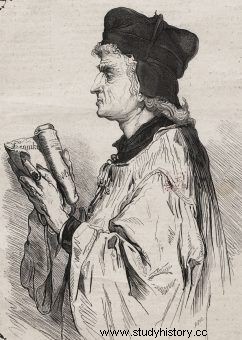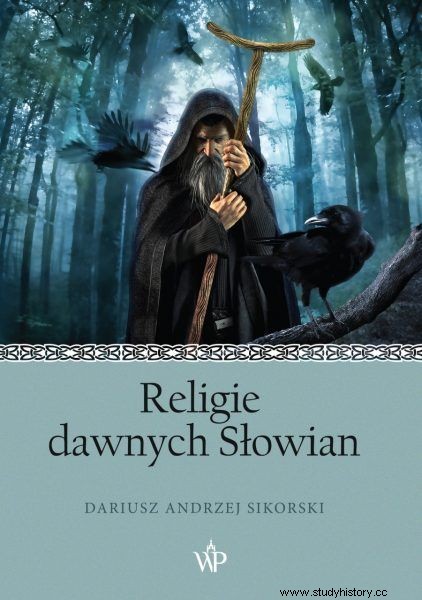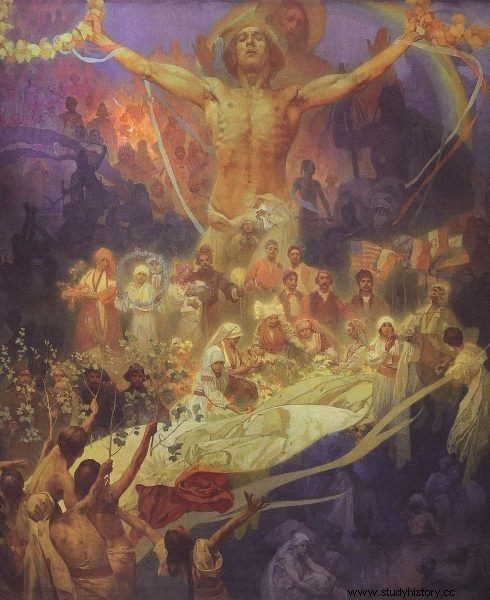The famous chronicler spoke about the pagan beliefs of Poles in amazing detail. He reconstructed the composition of the entire "Polish Olimp". But can the news of Jan Długosz be trusted?
Jan Długosz, who created in the second half of the 15th century, i.e. at the very end of the Middle Ages, in his monumental Annals he did not limit himself to times and events known from the autopsy. He went back to the very dawn of Poland, also taking up this topic in great detail.
In the first book of his work, he dealt with the issue of pagan beliefs practiced on the Vistula River before Mieszko was baptized and imposed a new faith on his subjects. As he wrote:
We also know about Poles that they were idolators from the beginning of their lineage and that they believed and worshiped many gods and goddesses, namely Jupiter, Mars, Venus, Diana and Cerera, having fallen into errors other nations and tribes.
They called Jupiter in their language as Jessa, believing that from him as supreme god they got all their temporal goods. They called Mars Lada. The imagination of the poets made him a leader and a god of war. They prayed to him for victory over their enemies. They called Venera Dzidzileyla and they considered her the goddess of marriage. They called Pluto Nija, considering him the god of the underworld and the guardian and protector of souls when the bodies left.
The description is surprisingly detailed and has sparked fierce debates for centuries. In the past, he was quite commonly taken at face value, believing that the words of Długosz reflected a certain reflex of original beliefs. This Slavic pantheon was to prove the complexity of the native religion, and even provide the basis for comparing it with the powerful systems of myths and beliefs of peoples such as the Greeks and Scandinavians.

Jan Długosz in the image of Jan Matejko.
After a period of fascination, the Długosz pantheon was looked increasingly skeptical. The renaissance of interest in him has, in fact, only taken place in recent years. Native believers and the so-called turbo-Slavs - dilettantes trying to prove on the basis of various forgeries and misdemeanors that Poland has an additional several thousand years of hidden, glorious history - refer to it as the crowning argument confirming their arguments.
But what do real specialists think about the Długosz pantheon? What is the current state of science?
Skillful compilation… nothing else?
First of all, it should be clearly stated that Długosz had no direct knowledge of the beginnings of Poland. He created half a thousand years after converting to Christianity. From pagan times he was separated by a similar distance to us ... from his own era. He could only write about the former pantheon as a historian:just as today's scientists write about himself.
The problem is, however, that Długosz had a very limited resource of sources. Contemporary scholars are largely of the opinion that his accounts concerning the period before the end of the fourteenth century are not very credible. As for the very beginning of the Annals - it was established that Długosz did not have any (I emphasize:no) source at work that we would not know at present.

Religion of the old Slavs without fabrications, manipulations and simplifications. Interpretation of an outstanding specialist shedding new light on the topic is already on sale.
He simply compiled chronicles written earlier, and at best embellished or reworked the stories they contained to suit his narrative and moralizing purposes. He showed the beginnings of Poland based on the works of Gall Anonim and Wincenty Kadłubek. But he had never seen the German chronicle of Thietmar with his eyes, so he had no idea about the many facts we now know about the earliest history of the country.
The re-enactment of Długosz means that no professional mediaists use the Annals reconstructing the origins of the Piast state. The same goes for the Slavic pantheon. Długosz simply relied on another source. By the way - he was completely carried away by fantasy.
Wedding chants
As it turns out, in the late Middle Ages, not only in Poland, but also in Ruthenia or the Czech Republic, wedding chants, in which such exclamations as "jessa", "nija", "leda" or "leli" were repeated, enjoyed a certain popularity. It should be emphasized that these folk songs were sung at the beginning of the 15th century, i.e. in an era in relation to which it is difficult to talk about the persistence of any visible relics of paganism.
The Church did not like the songs very much, which she saw in them perhaps completely incomprehensible, but still a reflection of old folk superstitions. The preacher Luke of Wielki Koźmin rebuked their repetition at wedding parties. Mentions on this subject also appeared in the synod statutes of 1414.

Apotheosis of the history of the Slavs. A work by Alfons Mucha from the beginning of the 20th century.
Superficial associations
Długosz apparently knew the opinions of the aforementioned Łukasz or was familiar with the synod documentation. The fears of the church authorities captured his imagination. And based on this incredibly late interpretation of folk customs, the historian began to compile a whole catalog of pagan beliefs.
He referred to the method popular in the Middle Ages. As explained by Dariusz Sikorski, Poznań medievalist and author of the book that has just been published Religions of the Old Slavs , "For Długosz, an educated man, paganism was synonymous with the form of religiosity he knew from ancient literature". So the chronicler decided that the old Poles had to believe in ... the same as the ancient Greeks or Romans, and only gave the gods different, native names.
As a result, the chronicler simply drew the general framework of the Roman religion, and the names of the Gods were taken from wedding calls. It was based, as Dariusz Sikorski emphasizes, on "superficial associations". And about the pagan religion "of course he had no knowledge, because how would he have had it five centuries after the baptism of Mieszko I".
Source:
The article was primarily based on the latest review of knowledge and research on pre-Christian beliefs of the Slavs, which came from the hand of a well-known medievalist and church historian, Dariusz Sikorski:
- D.A. Sikorski, Religions of the Old Slavs , Poznań Publishing House, Poznań 2018.
